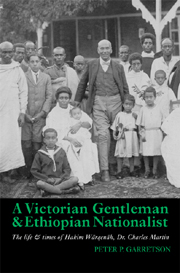 A Victorian Gentleman and Ethiopian Nationalist
A Victorian Gentleman and Ethiopian Nationalist Book contents
- Frontmatter
- Contents
- List of Illustrations
- Transliteration
- Note on the Ethiopian Calendar
- Glossary
- Acknowledgements
- Map 1 Ethiopia 1900–1950
- Map 2 Burma 1898–1919
- Introduction
- 1 Youth & education
- 2 Return to Ethiopia (1896–1901)
- 3 Campaigning in the Ogaden & return to Burma (1901–1907)
- 4 Transitions in life
- 5 A man of substance in Ethiopia & Burma
- 6 Return of a progressive to Addis Ababa (1919–1924)
- 7 An increased pace of modernization (1924–1930)
- 8 International diplomacy, education & recruitment
- 9 Governor of a model province, Chärchär (1930–1935)
- 10 Ethiopian ambassador to the Court of St. James (1935–1936)
- 11 London & India
- 12 Ethiopia
- Conclusion
- Bibliography
- Index
Conclusion
Published online by Cambridge University Press: 05 April 2013
- Frontmatter
- Contents
- List of Illustrations
- Transliteration
- Note on the Ethiopian Calendar
- Glossary
- Acknowledgements
- Map 1 Ethiopia 1900–1950
- Map 2 Burma 1898–1919
- Introduction
- 1 Youth & education
- 2 Return to Ethiopia (1896–1901)
- 3 Campaigning in the Ogaden & return to Burma (1901–1907)
- 4 Transitions in life
- 5 A man of substance in Ethiopia & Burma
- 6 Return of a progressive to Addis Ababa (1919–1924)
- 7 An increased pace of modernization (1924–1930)
- 8 International diplomacy, education & recruitment
- 9 Governor of a model province, Chärchär (1930–1935)
- 10 Ethiopian ambassador to the Court of St. James (1935–1936)
- 11 London & India
- 12 Ethiopia
- Conclusion
- Bibliography
- Index
Summary
Wärqenäh's stature as a major progressive in Ethiopian history has been underestimated in the past. It perhaps takes a biography to put his life in full perspective. It was as a progressive, both domestically in Ethiopia and internationally that he made his greatest contributions. Beyond that his life, so often, was the stuff of fiction rather than a life normally lived. First the dramatic events of the siege of Mäqdäla, an emperor's suicide and then his own ‘kidnapping’ at the age of three, followed by a peripatetic youth in north India leading to a plodding medical career in Burma. All the while his education was fostered by a bizarre alliance of military officers and dedicated missionaries. Without realizing it he became Ethiopia's first doctor, a most improbable event.
Following this romantic youth was an only slightly less dramatic middle age, still grounded in his Victorian upbringing. Wärqenäh's stodgy career in the prestigious Indian Medical Service was shaken to the core by the Battle of Adwa in 1896 and his abortive rush home to his birthplace. That set the stage for his eventual return three years later and medical service in the British diplomatic corps in the hot house atmosphere of Addis Ababa. Eventually he would serve three emperors and one empress of Ethiopia. This was all achieved by a boy brought up as an orphan Ethiopian in India with few prospects. Furthermore, after floundering through a series of difficult relationships with a variety of women in India and Britain, he dramatically married into one of Ethiopia's most aristocratic families.
- Type
- Chapter
- Information
- A Victorian Gentleman and Ethiopian NationalistThe Life and Times of Hakim Wärqenäh, Dr. Charles Martin, pp. 301 - 303Publisher: Boydell & BrewerPrint publication year: 2012
